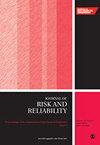可修负荷分担系统最佳可靠性的元件选择
IF 1.8
4区 工程技术
Q3 ENGINEERING, INDUSTRIAL
Proceedings of the Institution of Mechanical Engineers Part O-Journal of Risk and Reliability
Pub Date : 2023-09-02
DOI:10.1177/1748006x231193485
引用次数: 0
摘要
本研究确定了当在子系统级别进行维修时,每个子系统中最大限度地提高负载共享[公式:见文]系统的可靠性的组件数量。以往的研究已经得到了系统的可用性,假设对每个部件的故障进行修复。我们解释了统计流图模型如何用于计算系统可靠性,假设每个子系统的维修是反高斯分布,组件在固定负载下运行的寿命是指数分布。导出了系统状态间转移概率的封闭表达式和相应的等待时间分布的矩生成函数。通过比较使用不同数量部件的子系统的可靠性,我们解释了最优解是如何受到维修过程和子系统间部件同质性的影响的。我们发现,如果不考虑维修,使用在不同运行负载下具有最大可靠性的单个子系统是最优的,而如果对具有少量组件的子系统进行维修,则使用多个子系统是有益的。本文章由计算机程序翻译,如有差异,请以英文原文为准。
Component selection for optimal reliability of a repairable load-sharing system
This study determines the number of components in each subsystem that maximizes the reliability of a load-sharing [Formula: see text] out of [Formula: see text] system when repair is performed at the subsystem level. Previous studies have obtained the system availability given that repair is performed for each component failure. We explain how the statistical flowgraph model is used for computing system reliability under the assumption of an inverse Gaussian distribution for the repair of each subsystem and an exponential distribution for the lifetime of a component operating at a fixed load. A closed-form expression is derived for the transition probability between the system states and the moment generating function of the corresponding waiting time distribution conditional on the transition. By comparing the reliability of systems using different numbers of components in subsystems, we explain how the optimal solution is affected by the repair process and the component homogeneity among subsystems. We discover that, if repair is not considered, it is optimal to use a single subsystem that has the maximum reliability across different operating loads, whereas the use of multiple subsystems is beneficial if repair is performed for a subsystem with a small number of components.
求助全文
通过发布文献求助,成功后即可免费获取论文全文。
去求助
来源期刊

Proceedings of the Institution of Mechanical Engineers Part O-Journal of Risk and Reliability
ENGINEERING, MULTIDISCIPLINARY-ENGINEERING, INDUSTRIAL
CiteScore
4.50
自引率
19.00%
发文量
81
审稿时长
6-12 weeks
期刊介绍:
The Journal of Risk and Reliability is for researchers and practitioners who are involved in the field of risk analysis and reliability engineering. The remit of the Journal covers concepts, theories, principles, approaches, methods and models for the proper understanding, assessment, characterisation and management of the risk and reliability of engineering systems. The journal welcomes papers which are based on mathematical and probabilistic analysis, simulation and/or optimisation, as well as works highlighting conceptual and managerial issues. Papers that provide perspectives on current practices and methods, and how to improve these, are also welcome
 求助内容:
求助内容: 应助结果提醒方式:
应助结果提醒方式:


